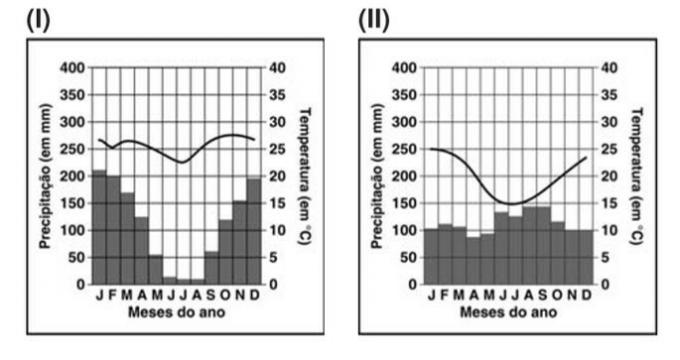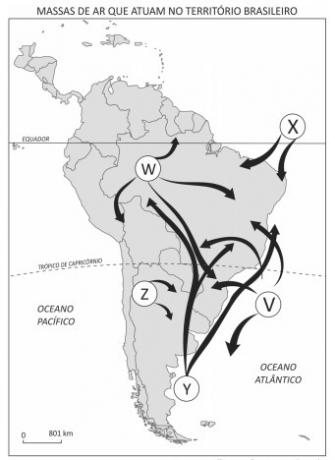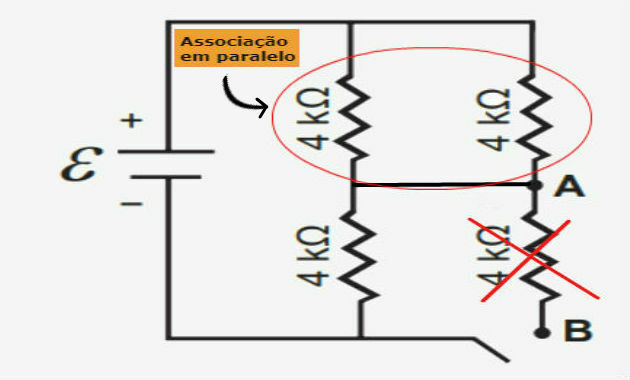Test your knowledge of the climate in Brazil with the 10 questions Next. Check out the comments after the feedback to get your questions answered.
question 1
Brazil has most of its territory geographically located in the Southern Hemisphere, between the Equator and the Tropic of Capricorn.
Check the alternative that does NOT have climates from Brazil.
a) Tropical Atlantic and Tropical Altitude
b) Seasoned and Mediterranean
c) Equatorial and Tropical
d) Subtropical and Semiarid
Incorrect alternative: b) Seasoned and Mediterranean.
Brazil has most of the territory located in the Tropical Zone, so hot and humid climates predominate in the territory. The main types of Brazilian climates are:
equatorial climate: characterized as hot and humid. Occurs in regions close to the equator.
Tropical weather: Presents well-defined periods of rain and drought, in addition to high average annual temperatures. Occurs in the central region of Brazil.
Subtropical climate: is influenced by the Atlantic polar mass and is characterized by its high thermal amplitude. Occurs in regions below the tropic of Capricorn.
Semi-arid tropical climate: characterized by sparse and irregular rains. Occurs in the region of the drought polygon in northeastern Brazil.
Atlantic Tropical Climate: located in most of the Brazilian coast.
Altitude Tropical Climate: located in elevated areas, usually above 800 meters.
question 2
Regarding the types of climate in Brazil, correctly relate the climate (column 1) to the region where it is found (column 2).
| Climate | Brazilian region |
|---|---|
| 1. Equatorial | The. Typical of the Northeast Region |
| 2. Tropical | B. Predominant in the North Region and in part of the Midwest Region |
| 3. Altitude Tropical | ç. Predominant in much of the Brazilian coast |
| 4. Tropical Atlantic | d. Found in the central region of Brazil and predominant in the Midwest Region |
| 5. Subtropical | and. Predominant in the mountainous areas of the Southeast Region |
| 6. Tropical Semiarid | f. Predominant in the South Region |
The correct sequence is:
a) 1.f; 2.a; 3.c; 4.e; 5.b; 6.d
b) 1.b; 2.d; 3.e; 4.c; 5.f; 6.a
c) 1.e; 2.c; 3.b; 4.d; 5.a; 6.f
d) 1.c; 2.f; 3.a; 4.b; 5.d; 6.e
Correct alternative: b) 1.b; 2.d; 3.e; 4.c; 5.f; 6.a
The weather equatorial predominates in the North Region and is found in part of the Midwest Region.
The weather Tropical it is found in the central region of Brazil and predominates in the Center-West region.
The weather Altitude Tropical predominates in the mountainous areas of the Southeast Region.
The weather Tropical Atlantic is found in much of the Brazilian coast.
The weather Subtropical predominates in the Southern Region.
The weather Tropical Semiarid it is characteristic of the Northeast Region.
question 3
Identify which climate in column 1 has the characteristics described in column 2.
| Climate | Features |
|---|---|
| The. Equatorial | ( ) presents high temperatures, regular rainfall and is influenced by the Tropical Atlantic air mass |
| B. Tropical | ( ) has low thermal amplitude and is found in regions with altitudes above 800 meters |
| ç. Tropical Atlantic | ( ) has a lot of rainfall and high temperature |
| d. Altitude Tropical | ( ) has long periods of drought and high temperatures |
| and. Subtropical | ( ) can be divided into well-defined dry and rainy seasons |
| f. Tropical Semiarid | ( ) in winter, temperatures drop and frost and even snow may occur |
The correct sequence is:
a) a, b, c, d, e, f
b) b, e, f, a, c, d
c) f, e, d, c, b, a
d) c, d, a, f, b, and
Correct alternative: d) c, d, a, f, b, e.
The. The weather Equatorial presents a great amount of rain and high temperature, being common in forest regions.
B. The weather Tropical it can be divided into well-defined dry and rainy seasons, as winter is dry and with mild temperatures, unlike summer, which is hot and rainy.
ç. The weather Tropical Atlantic or Coastal Tropical it has high temperatures, regular rainfall and is influenced by the Tropical Atlantic air mass.
d. The weather Altitude Tropical it has a low thermal amplitude and is found in regions that have altitudes above 800 meters and therefore have the lowest temperatures in the tropical domain.
and. The weather Subtropical it has a hot summer and severe winter, when temperatures drop and frost and even snow can occur.
f. The weather semiarid it has long periods of drought and high temperatures, with annual averages around 27 ºC.
question 4
Regarding the equatorial climate, check the correct alternative.
a) It has a low incidence of solar radiation and therefore the average annual temperatures are low.
b) The heavy rainfall and high air humidity are related to the Atlantic Equatorial air mass that influences the region.
c) It is characteristic of regions with dense forests, such as the Amazon Forest and the Congo Forest, as it favors the existence and great biodiversity.
d) It is subdivided into dry equatorial climate and wet equatorial climate.
Correct alternative:
a) WRONG. This climate is characterized by the intense incidence of solar radiation. Thus, it has high temperatures that are between 26 ºC and 28 ºC.
b) WRONG. The air mass that influences the region is the continental air mass and the high temperatures cause greater evaporation and consequently a lot of rain and high air humidity.
c) CORRECT. This climate is located in the range around the equator. The Amazon Forest is the largest equatorial forest in the world.
d) WRONG. Its subdivisions are wet equatorial and semi-humid equatorial, which differ by the amount of rainfall.
question 5
Although time and climate are often used as synonyms, these words have different meanings because
a) The climate is influenced by factors such as precipitation and solar radiation. Time is a direct result of the influence of air masses.
b) Weather refers to momentary weather conditions and climate represents a weather pattern observed over the years.
c) The climate of a region is the result of geographic factors and the weather is influenced by meteorological conditions.
d) Weather refers to the temperature and rainfall in a location, while the climate gathers information on atmospheric pressure, continentality and maritime nature.
Correct alternative: b) Weather refers to momentary weather conditions and climate represents a weather pattern observed over the years.
Atmospheric weather refers to a momentary state, that is, the weather conditions of a location at a given time. The climate, on the other hand, gathers lasting information that was obtained from the types of times recorded in at least 30 years in a region.
question 6
Morphoclimatic domains are broad geographic classifications that involve climate, hydrography, vegetation, relief and soil that relate to and characterize a particular region.
Brazil has six morphoclimatic domains: Amazon, caatinga, hilly seas, cerrado, araucarias and prairies.
As for the climate, for example, the Amazon domain and the Caatinga domain are distinguished by having, respectively, the climates
a) Tropical and Desert
b) Equatorial and Semiarid
c) Continental Tropical and Coastal Tropical
d) Temperate and Subtropical
Correct alternative: b) Equatorial and Semiarid.
The largest morphoclimatic domain in Brazil is the Amazon domain, which features the Equatorial climate. The region's climate is hot, humid, with rainfall well distributed throughout the year and average temperatures around 24 ºC and 27 ºC.
The morphoclimatic domain of the Caatinga presents a semiarid climate, characterized by high average annual temperatures and long dry periods.
Learn more about morphoclimatic domains.
question 7
Air masses are large portions of air that directly influence the climate as they have, for example, characteristic temperature and humidity.
The air masses that affect the Brazilian territory are classified as _________, _________ and ___________, according to latitude, and by origin in _________ or _________.
The words that correctly fill the text are:
a) temperate, polar, subtropical, continental and coastal
b) Mediterranean, Antarctic, subtropical, hot and cold
c) temperate, glacial, desert, southern and coastal
d) equatorial, tropical, polar, continental and maritime
Correct alternative: d) equatorial, tropical, polar, continental and maritime
The air masses that affect the Brazilian territory are classified into equatorial, tropical and polar, according to latitude, and by origin in continental or maritime.
Equatorial air masses form near the equator, while tropical air masses originate near the tropic of Capricorn. There are also the polar masses that arise to the south.
The air masses that stand out in Brazil are:
Hot air: Equatorial Continental, Equatorial Atlantic, Tropical Continental and Tropical Atlantic
Cold air: Polar Atlantic
Learn more about air masses.
question 8
(UEL) The climogram is a graphical form of representation of the climate that indicates the thermal average and rainfall in a given location. Its column indicates the precipitation and the line the temperature (in °C).
Based on your knowledge of weather types, relate the following climograms to Brazil's weather types.


a) The Equatorial Climate is characterized by the domain of the Continental Equatorial air mass, with annual average temperature around 24 °C, and annual rainfall around 2500 mm.
b) The Subtropical Climate is characterized by the dominance of the Atlantic Tropical, Continental Tropical and Polar air masses Atlantic, with average annual temperature around 18 °C and rainfall around 1500 mm annually well distributed during the year.
c) The Tropical Climate is characterized by the dominance of the Atlantic Tropical, Continental Tropical and Continental Equatorial, with an annual average of 24 °C, two well-defined seasons and rainfall around 1500 mm annual.
d) The semi-arid climate is characterized by the dominance of the Atlantic Equatorial and Atlantic Tropical air masses with average annual temperature of 27 °C and rainfall around 750 mm, irregularly distributed during the year.
Check the alternative that contains the correct association.
a) I-A, II-B, III-C, IV-D
b) I-B, II-C, III-D, IV-A
c) I-C, II-B, III-D, IV-A
d) I-C, II-D, III-A, IV-B
e) I-C, II-A, III-B, IV-D
Correct alternative: c) I-C, II-B, III-D, IV-A.
question 9
(UFRN) An important characteristic of the types of climate in Brazil is the predominance of tropicality, which arises from the location of most of its territory in the so-called “intertropical zone of the Planet". The influence of certain factors, such as altitude, latitude, continentality, sea and air masses, interfere in the configuration of different temperature, humidity and precipitation indices.
Note the following climograms:

Based on the climograms and climatic characteristics existing in Brazil, it is correct to state that:
a) Climogram 1 refers to the humid equatorial climate, which covers most of the Amazon and presents high temperatures and rainfall well distributed throughout the year.
b) Climogram 2 refers to the humid coastal tropical climate, which predominates in the Northeast and presents high temperatures and irregular rainfall.
c) Climogram 1 refers to the tropical climate, which covers the Center-West Region, characterized by high levels of precipitation and low temperatures.
d) Climogram 2 refers to the humid subtropical climate, which prevails in the South Region, characterized by irregular rainfall and high temperatures.
Correct alternative: a) Climogram 1 refers to the humid equatorial climate, which covers most of the Amazon and presents high temperatures and rainfall well distributed throughout the year.
question 10
(Fuvest)

M.E.Simielli. Geoatlas, 2010. Adapted.
Brazil has an extensive territory, with 92% belonging to the intertropical zone. The air masses that operate in Brazilian territory have oceanic and continental influences. Regarding the characteristics of these air masses, it is correct to state:
a) W represents the Atlantic Equatorial Mass of hot and humid air, responsible for the great humidity in the Amazon.
b) Y indicates the Atlantic Polar Mass, which moves from the south towards the north of the territory Brazilian and is characterized by the presence of cold air, which can reach the Midwest region in the Winter.
c) Z indicates the Continental Tropical Mass, which is characterized by the presence of hot and humid air, causing flooding in the Midwest in winter.
d) X indicates the Continental Equatorial Mass of hot and dry air, which acts in the northeast of the Brazilian coast.
e) V represents the Atlantic Temperate Mass of cold and dry air, which operates in the south of the Brazilian coast.
Correct alternative: b) Y indicates the Atlantic Polar Mass, which moves from the south towards the north of the Brazilian territory and is characterized by the presence of cold air, which may reach the Midwest region in the Winter.
Get more knowledge with the contents:
- Relief Exercises
- Brazil climates
- Thermal Zones
- Types of weather
- Difference between weather and climate
- Factors influencing the climate



